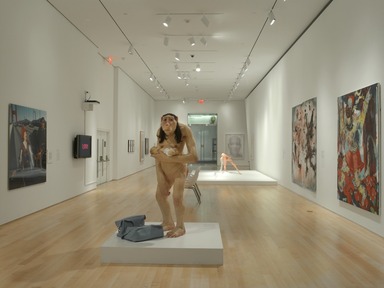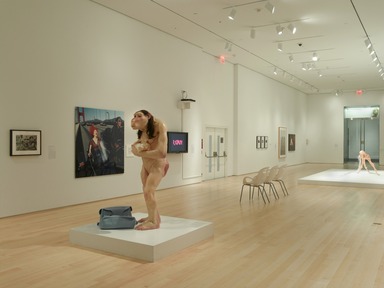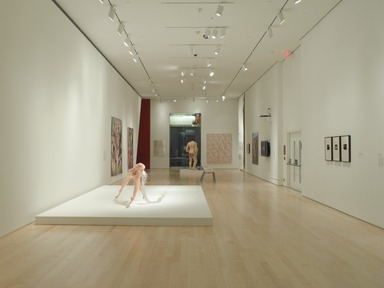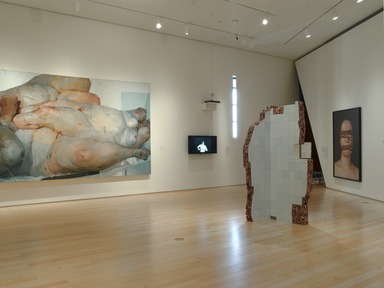

Global Feminisms Remix, August 3, 2007 through February 3, 2008 (Image: DIG_E2007_Global_Feminism_Remix_01_PS2.jpg Brooklyn Museum photograph, 2007)

Global Feminisms Remix, August 3, 2007 through February 3, 2008 (Image: DIG_E2007_Global_Feminism_Remix_02_PS2.jpg Brooklyn Museum photograph, 2007)

Global Feminisms Remix, August 3, 2007 through February 3, 2008 (Image: DIG_E2007_Global_Feminism_Remix_03_PS2.jpg Brooklyn Museum photograph, 2007)

Global Feminisms Remix, August 3, 2007 through February 3, 2008 (Image: DIG_E2007_Global_Feminism_Remix_04_PS2.jpg Brooklyn Museum photograph, 2007)

Global Feminisms Remix, August 3, 2007 through February 3, 2008 (Image: DIG_E2007_Global_Feminism_Remix_05_PS2.jpg Brooklyn Museum photograph, 2007)

Global Feminisms Remix, August 3, 2007 through February 3, 2008 (Image: DIG_E2007_Global_Feminism_Remix_06_PS2.jpg Brooklyn Museum photograph, 2007)
Global Feminisms Remix
-
Introduction
Global Feminisms, recently on view at the Brooklyn Museum, was the first major exhibition to examine international feminist art at the turn of the twenty-first century. A selection of works from that exhibition remains on view here in Global Feminisms Remix.
Like its widely praised predecessor, Remix calls attention to the fact that feminism is a truly global issue. Assembled here are works in a wide range of media made by 40 women artists from around the world and born since 1960. Many of the artists come from countries seldom included in the discourse on contemporary art, among them Guatemala, Kenya, Pakistan, Thailand, Korea, and India.
Remix, like the earlier exhibition, seeks to challenge the dominance of European and American contemporary art, as well as the concept of a “global sisterhood,” a term that assumes a universal sameness among women without taking into account social, racial, ethnic, economic, sexual, and cultural differences. By making feminism a plural noun, feminisms, we mean to imply that there is not one single, unitary feminism any more than there is a universal “woman.” We hope that this show constitutes a reclamation of difference—seeing it as a major positive force in the human situation, rather than a crippling predicament. It is only through the acceptance of difference in its many varieties that art, and society, can change.
Maura Reilly and Linda Nochlin
Curators of the Exhibition
-
May 7, 2007
Forty-four works selected from Global Feminisms are once again on view at the Brooklyn Museum in the Elizabeth A. Sackler Center for Feminist Art. Like its widely praised predecessor, Remix seeks to challenge the dominance of European and American contemporary art and explore such issues as racial and gender identity, politics, and oppression.
Remix assembles works by 40 women artists, who represent countries that are seldom involved in the contemporary art discourse such as Guatemala, Kenya, Pakistan, Thailand, Korea, India. The wide range of media employed in the exhibition includes paintings, sculpture, photography, works on paper, and video.
In this exhibition, many of the artworks are infused with political activism. From Afghanistan, Lida Abdul is represented by a single-channel video White House (2005), which shows the artist white-washing a building in bombed-out Kabul. Sigalit Landau, an Israeli video artist, swings a barbed wire hula-hoop around her naked, bloody stomach in which pain symbolizes the geographical barrier created along the West Bank. Regina José Galindo is seen making a bloody footprint with each step as she walks from the Court of Constitutionality to the National Palace in Guatemala City in memory of murdered Guatemalan women, in her performance video Who Can Erase the Traces? (2003).
While other exhibiting artists’ themes are not as politically charged, they do create intense, emotive works that celebrate social freedoms or confront oppression. From Japan, Miwa Yanagi’s photograph from My Grandmothers series, depicts an elderly model with flaming-red hair riding sidecar on a motorcycle driven by her young lover. Japanese artist Ryoko Suzuki contributes a mural-sized installation of three photographs in which her face is bound tightly by pig’s intestines, where she is bullied into a kind of mute, anonymous submission.
Among the artists represented are Ghada Amer (Egypt), Arahmaiani (Indonesia), Pilar Albarracín (Spain), Pipilotti Rist (Switzerland), Tracey Moffatt (Australia), Lilibeth Cuenca Rasmussen (Denmark), and Tracey Rose (South Africa).
The specific works have been chosen by Co-Curators Maura Reilly, Curator of the Elizabeth A. Sackler Center for Feminist Art, and Linda Nochlin, Lila Acheson Wallace Professor of Modern Art at the Institute of Fine Arts, New York University
View Original

